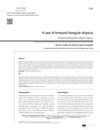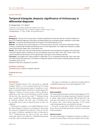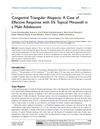A Case of Unilateral Congenital Triangular Alopecia
January 2020
in “
Przegla̧d dermatologiczny
”

TLDR A 5-year-old boy was diagnosed with congenital triangular alopecia, a type of hair loss without skin changes, usually starting between ages 2-5, with no specific treatment.
In 2020, a case study was conducted on a 5-year-old male patient who presented with hair loss on his scalp. The patient was diagnosed with congenital triangular alopecia (CTA), also known as temporal triangular alopecia (TTA), a persistent, asymptomatic, non-cicatricial type of alopecia. This condition usually manifests as hair loss without any skin changes, limited to the frontotemporal region of the scalp. The alopecia can be triangular, oval, or lancet-shaped, and fine vellus hair may be present. CTA is considered congenital but can also be acquired due to the miniaturization of hair follicles. It usually occurs between the ages of 2-5, but can also occur from birth or develop in adulthood. It is generally unilateral but can be bilateral in 20% of cases. In an analysis of 6200 patients, triangular alopecia was detected in 7 of the patients. Dermoscopy shows normal follicular openings and vellus hair in the alopecia patch, distinguishing CTA from other types of alopecia. There is no specific treatment for CTA.




